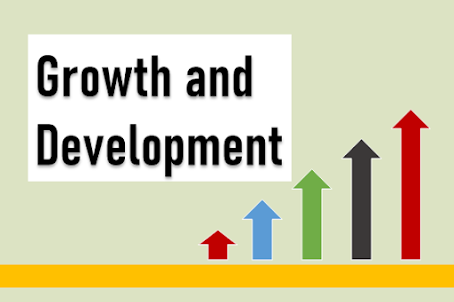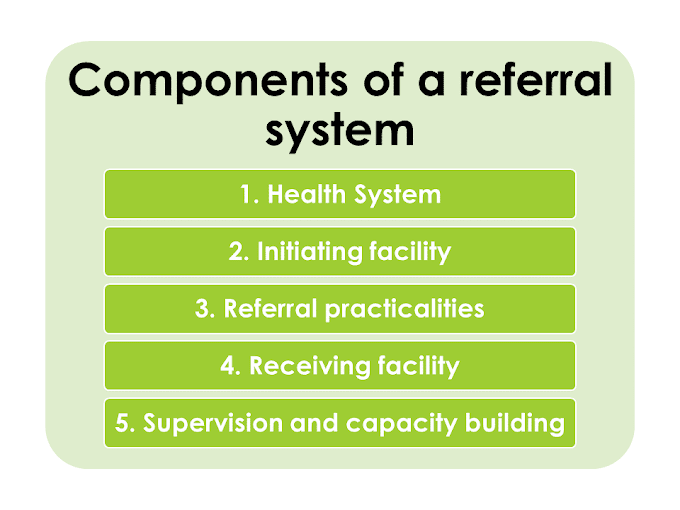Definition of Growth and Development
Growth:
Growth is the increase in the size and mass of the body and organs due to multiplication, differentiation and expansion of cells and increase in intra cellular substance.
Growth is a quantitative indicator and in this length is measured in cm, meter, inch, and weight in kg, gm or pound.
Development:
Development is the process of functional and physiological maturation of an individual. It is the progressive increase in skill and capacity to function.
Development
is related to maturation and myelination of the nervous system.
Development
is a qualitative parameter so its measurement is very difficult
then
the
growth.
Nature of Growth and Development
- Growth and development are continuous and orderly process with individual difference and is unique in each child.
- Every individual has unique growth pattern but overall growth order of all person is similar.
- Development progress by “general to specific rule’’
- Growth is deferent in different times or organs of body.
- Growth proceeds from the head down to the tail, or in a cephalocaudal direction. This is particularly evident during the period of gestation and the first year of life. Before birth, the head end of the embryo and fetus enlarges and develops before the tail end does. Postnatally, the infant can control the movement of the head before being able to control the feet.
- Growth proceeds from the center, or midline, of the body to periphery, or in a Proximodistal direction. During the prenatal period, the limb buds develop before the rudimentary fingers and toes. During infancy, the large muscles of the arms and legs are subject to voluntary control earlier than are the fine muscles of the hands and feet.
Stages of Growth and Development
Prenatal Period:
- Ovum: 0 to 14 days.
- Embryo:14 days to 8 weeks.
- Fetus: 8 weeks to birth.
Postnatal Period:
- New Born/Neonate: Birth to 4 weeks.
- Infant: Birth to 1 year.
- Toddler: 1 year to 3 years.
- Pre-School age: 3 years to 6 years.
- School age: 6 years to 12 years.
- Adolescent: 12 years to 18 years.
Factor Affecting Growth and Development
Genetic of Fetus:
- Chromosomal abnormalities in growing fetus causes the deferent types of defect like Down Syndrome, Turner Syndrome etc.
- Gene abnormalities defects e.g. Thalassemia, Hemophilia etc.
- Gender of growing fetus
- Race and Nationality
Prenatal Factors:
- Maternal malnutrition
- Maternal substance abuse e.g. drugs, thalidomide, phenytoin, smoking, alcohols etc.
- Maternal illness e.g. pregnancy induce hypertension, anemia, heart disease, hypothyroidism, diabetic mother, iodine deficiency
- Hormonal abnormality in pregnant women mainly thyroxin and insulin hormone.
- Maternal infection e.g. HIV, Hepatitis B virus, and STORCH infection.
T – Toxoplasmosis
O – Others: HIV, Chickenpox (Varicella zoster virus), Parvovirus B19
R – Rubella
C – Cytomegalovirus
H – Herpes simplex virus
Postnatal Factors
- Nutrition of children after birth like breastfeeding and starting of weaning food at right time.
- Childhood illness
- Family and school environment of child
- Socio economic status family affect the growth and development. High income of family better food availability then poor family child.
- Hormonal imbalance in children
- Play and exercise promote better growth and development.
Assessment of Growth
Anthropometry is a Greek word.
Anthropos – Man; and Metron – measure.
Parameters of Growth Assessment in Children
(A) Weight:
- Weight is one of the best criteria for assessment of growth and it is a good indicator of health and nutritional status of child.
- Normally most of child weight at birth is between 2.5 kg to 3.8 kg of an Indian mother newborn baby.
- There are about 10% loss of weight occur during the first 7 days life of newborn and then after baby start to gain weight by 10th day.
- The weight gain is about 25 – 30 gm per day for first 3 months and 400 gm per month till one year of age.
- Infant doubles their birth weight at 5 months of age.
- Triples their birth weight at1 year of age.
- Quadruples their birth weight at 2 years of age.
- A health personal measure the weight of infant in infant weighing machine with minimum cloths, and use the same weight machine for subsequent assessment.
- During weight assessment prevent the infant form hypothermia.
(B) Length and Height:
- At birth average length of healthy Indian new born baby is 50 cm. Normally it is in between 45 cm to 55 cm in range.
- The length of child is double at the age of 4 to 4.5 years of age.
- The length is more reliable criteria of gestational age of baby then the weight.
- The length of infant is measure by Infantometer.
(C) Head Circumference:
- At birth the head circumference of newborn is about 33 to 35 cm.
- At 12 years of age the head circumference at list adult size 52 cm.
- A occipital-frontal head circumference is measure by the non-elastic tape, and tap is placed the mid point of frontal bone.
- Microcephaly is a medical term used when the head circumference that is > 2 standard deviations (SD) below the mean compared to age-and gender-matched population-based samples.
(D) Chest Circumference:
- At birth newborn baby chest circumference is 2-3 cm less than the head circumference.
- The circumference of head and chest is equal at the age of 1 year than after chest circumference is more than head.
- The measurement of newborn baby chest circumference is done at the point of nipple line of both breast with non-elastic measuring tape.
(E) Body Proportion:
- It is the upper and lower body segment ratio.
- Upper and lower segment is measure from symphysis pubis.
- At birth the body proportion of newborn is 1.7:1
- At 3 years – 1.3:1
- At 10 to 12 years 1:1
(F) Mid Upper Arm Circumference:
- It is a circumference of upper arm at a mid point between the olecranon process and acromium.
- It is measures by the use of MUAC tape.
- At birth the circumference is between 11 to 12 cm, and age 1 year 12-16 cm. At age 15 years the circumference is between 20 to 21 cm.
- Mid upper arm circumference assessment are used to find out malnutrition in children.
Assessment of Development
(A) Developmental Mile Stone Parameter of Infant
- Give smile.
- Turn head side to side.
- Cries.
- Follow the objects.
- Hold head in mid line.
(ii) 4-5 Months Baby:
- Grasps objects in hands.
- Rolls over for the first time.
- Enjoy the social interaction.
- Begins to show memory.
- Aware of unfamiliar surroundings.
- Hold head steadily in upright position.
- Sits with support.
- Smile at self in mirror.
- Begins to discriminate family members from stranger.
- Responds when own name is spoken.
(iii) 6-7 Months Baby:
Creeps.
- Start to sits without support.
- Exhibits fear to stranger.
- Hold arms out.
- Frequent mood swings.
- Wave bye-bye.
- Transfer objects from one hand to another hand.
- Rolls more easily from back to abdomen.
(iv) 8-9 Months Baby:
Sits steadily unsupported.
- Crawls.
- May stand while holding on.
- Knows what “no” means.
(v) 10-11 Months Baby:
Can change from prone to sitting passion.
- Walks while holding on to furniture.
- Stands securely.
- The infants say “mama” and “dada”.
- Picks small objects up with index finger and thumb.
(vi) 12-13 Months Baby:
- Walks with one hand held.
- Can take a few steps without falling.
- Can drink from a cup.
- Good pincer grasp.
(vii) 14-15 Months Baby:
Walks alone.
- Can crawl upstairs.
- Show emotion such as anger and affection.
- Will explore away from mother in familiar surrounding.
(B) Developmental Mile Stone Parameter of Toddler
- The toddler period included the age of 1 to 3 year. This is a slow growth period with a weight gain of 2-4 kg over two years.
- The toddler shows following behavioral character or physiological character.(i) Egocentricity
(ii) Frequent temper tantrum.
(iii) Experience separation anxiety - The toddler begins to walk one hand held by age 12-13 month.
- The toddler run- jump by age 2 years.
- Rides a tricycle by age 3 year.
- Use at list 400 words (with two to three-words phrases) by the age 2 year.
- It increases about 900 words by age 3 year.
- The toddler is ready for the toilet training.
- Bowel control develops before the bladder control.
- By the age three the toddler achieves fairly good bowel and bladder control.
- The toddler may stay dry during the day time but may need a diaper at night until about age 4 year.
(C) Developmental Mile Stone Parameter of Pre-School Age Child
- Pre-schooler is 3 to 6 year age child.
- The preschooler grows 2.5 to 3 inches per year.
- The average height 37 inches at age 3 year and 43 inches at age 5 years.
- The preschooler gain weight 5 pound per year.
- The regular dental care is needs.
- The preschooler has good posture.
- The child develops fine motor co-ordination.
- The child can hop-skip and run more smoothly.
- The child can tie shoelaces by age 6 years.
- The child may talk continuously and ask many “why” questions.
- The vocabulary increases 2100 words by age 5 year.
- By age 4 the preschooler speaks five to six words sentences that contain all parts of speech.
- By age 4 has day time control of bowel and bladder but may experience wetting accidents at night.
- By age 5-achive complete bowel and bladder control although accident may occur in stressful situation.
(D) Developmental Mile Stone Parameter of School Age Child
- School age child is 6-12 year.
- Girls usually grow faster than boys.
- Growth is about 2 inches per year between ages 6 to 12 years.
- Height ranges from 45 inches at age 6 and 59 inch at age 12 year.
- Weight gain about the rate of 4.5 to 6.5 pounds per year.
- Regular dentist visits are necessary at this age group.
(E) Developmental Mile Stone Parameter of Adolescent Age Child
- Puberty age and it is age of 12 to 18 years.
- Age of rapid growth and development.
- Body mass increase to adult size.
- Development of secondary sexual characters.
- Sebaceous and sweat glands are active.
- Body hair distribution occur.
- Increase in height, weight, breast development and pelvic girth occur in girls.
- In boys, increase in height, weight, muscle mass, and penis or testicle size occur.
- The voice deepens in boys.
- Normal weight gain during puberty: (i) Girls gain – 15-55 pounds. (ii) Boys gain -15-65 pounds.





0 Comments